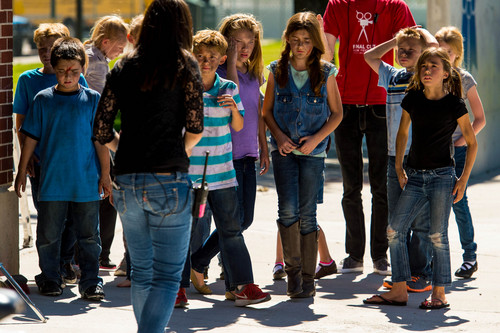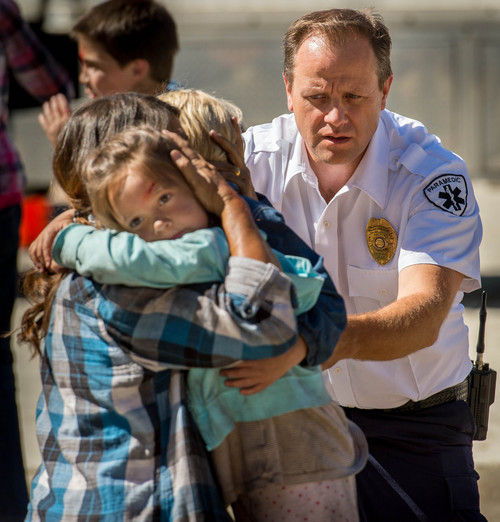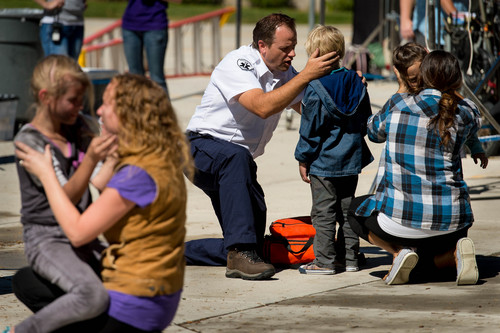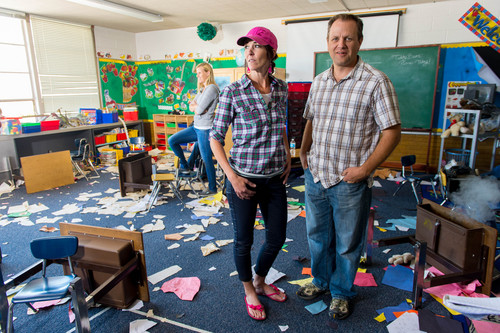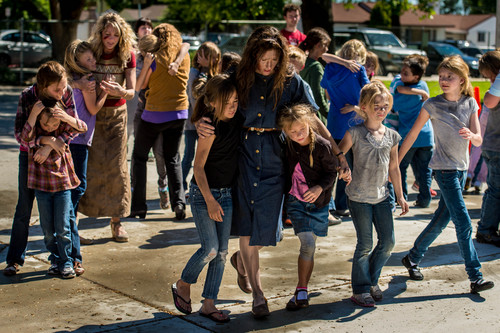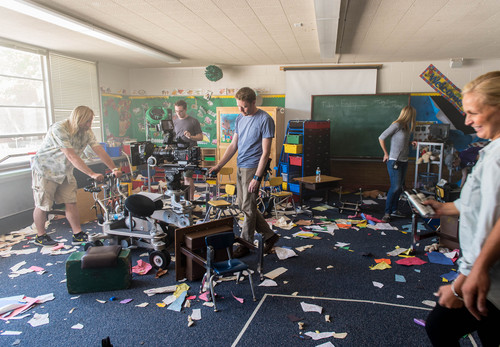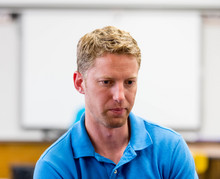This is an archived article that was published on sltrib.com in 2014, and information in the article may be outdated. It is provided only for personal research purposes and may not be reprinted.
Before the bomb exploded, blocking out the sun and sending panicked children running, Lori Nate Conger prayed.
She and other fifth-graders held hands, asking God to save them from the deranged man and woman who held them hostage at school.
"I remember thinking there's a lot of things this guy thinks he can do," said Conger, now 39 and living in Kaysville, "but he can't stop us from praying, that's for sure."
In what many have since labeled a miracle, all of the 154 children and educators held hostage for three hours at their Cokeville, Wyoming, school lived, though many were injured. Only the man and his wife, who accidentally detonated the bomb, died that day in 1986.
Now, 28 years later, Conger and more than a dozen other survivors are reliving the event, literally. They've been working as extras in a movie about it being filmed partly at Whitesides Elementary in Layton. In many cases, they've also invited their children to participate, some of whom are now the same age as they were in 1986.
Why would they want to re-enact that terrible day?
Because to many of the survivors it wasn't a tragedy; it was a miracle.
"It's been a pretty surreal and extraordinary experience to relive this again," Conger said. "It's really caught me off guard a few times and choked me up, but it's been something I'll never forget. It's made me remember again how blessed we were."
The film will focus on the miraculous nature of the day, including the prayers and faith it inspired, said co-producer, Ron Tanner. Tanner is producing the movie with filmmaker T.C. Christensen, who has become known for making LDS films. But Tanner said they hope this movie won't be labeled that way. In fact, the film won't even mention The Church of Jesus Christ of Latter-day Saints, he said, though many of the students were Mormons in real life.
"We think this could have happened anywhere, and we don't want people outside the church to feel this is exclusive to us," Tanner said.
"There is a lot of bad that happens in the world, and a lot of people get hurt, but sometimes good things happen and there are people who are saved, and I think when that happens we have to tell these stories so people have hope," he said.
It's an especially important message now, the survivors feel, amid seemingly weekly reports of school violence across the country.
"Every time one of these kinds of things happens, all of us survivors, our hearts break," said Kamron Wixom, who was in sixth-grade when Cokeville's former marshal, David Young and his wife, Doris Young held him and his classmates hostage.
When the bomb went off, Wixom was blown out the door and ran. He doesn't remember the sound of the bomb detonating, but he does recall seeing a strange, hazy light in the room shortly before the blast. He didn't know what to make of it at the time, but other survivors have since reported seeing angels, and he wonders now if that's what it was.
Wixom, now 40 and living in Saratoga Springs, also remembers praying. Despite the terror that filed the room, the prayers made him feel "like everything was going to be fine."
Joshua Wiscombe, now 34 and living in Layton, also remembers a feeling of peace coming over him right before the bomb exploded.
Wiscombe was only a kindergartner at the time, but he still recalls the blast and the fear that followed.
"I just remember that loud, loud sound going off and then it was pitch black," Wiscombe said. "The last thing I remember seeing was fire at my feet, and I remember thinking, 'I'll never see my mom again.' "
It's been tough for the survivors to go through it all again — even amid the safety of a film set. And it's been difficult to see their kids re-enacting what they experienced almost three decades ago.
The survivors and their kids spent several days acting out scenes in the classrooms and outside the school. Their faces were smeared with fake ash and blood.
But the kids didn't seem scared. Instead, they felt honored to essentially play younger versions of their parents.
"I like to pretend I'm my mom," said a smiling Regyn Conger, 9.
Kamaya Wixom, who at 12, is now about the same age as her father when he was held hostage, said, "It's nice to be able to feel what he went through."
Kamron Wixom said he believes it will ultimately be good for his kids.
"It was a positive story," he said of the crisis. "It's a faith-promoting thing and a good thing for our kids to have a little more connection to."
Kamron Wixom also ended up as an extra in the filming. On Thursday, he dressed as a paramedic, comforting a little girl and boy running out of the school — a little boy that could have been him 28 years ago.
Conger also worked as an extra, pretending to be a worried parent waiting outside the school. It wasn't difficult for Conger, now a mother of five, to imagine what her mother, who also had five kids, must have gone through that day.
"It wasn't hard for me to cry," she said of acting out the scene.
But Conger hopes the difficulty of reliving the events will be worth it. She feels a responsibility as a survivor to share her story, which she sees as one of hope and faith.
"I thought it was time to tell the vital parts of the story," Conger said, "and let people know miracles happen and prayers are answered." —
Background on the Cokeville school bombing
— David Young, 43, and his wife, Doris Young, 47, entered Cokeville Elementary in Wyoming at 1:20 p.m. on May 16, 1986, and held 154 students, teachers and administrators hostage in a classroom. The captors demanded $300 million in ransom to finance a long-planned revolution.
— At 3:40 p.m., Doris Young accidentally detonated a firebomb, injuring nearly 80 children and adults. More than 20 had to be hospitalized with burns.
— Doris Young was seriously injured in that blast. But an autopsy revealed she died from a gunshot to the head. Minutes after the explosion, David Young shot himself to death.
— During the standoff, David Young handed out copies of a rambling memo to hostages with references to Socrates, nuclear war, Christ, Hitler and the "nothingness of knowledge."
— In 1979, David Young was Cokeville's town marshal and was jokingly referred to as Wyatt Earp because he wore long-barreled pistols in gunslinger-type holsters strapped to his leg. The mayor fired Young because, "he was a weirdo who wouldn't follow orders or do his job."
— Sheriff's investigator Ron Hartley, who read dozens of Young's diaries, believes he targeted Cokeville because he considered the children to be intelligent and he wanted them to surround him in a reincarnated world that he would dominate.
Source: Salt Lake Tribune archives


